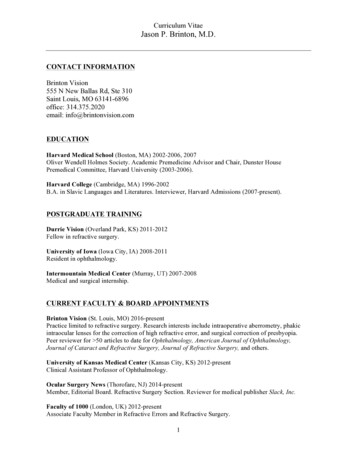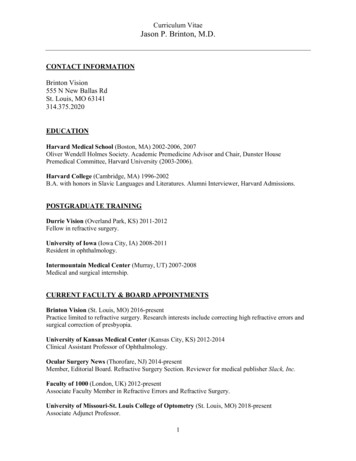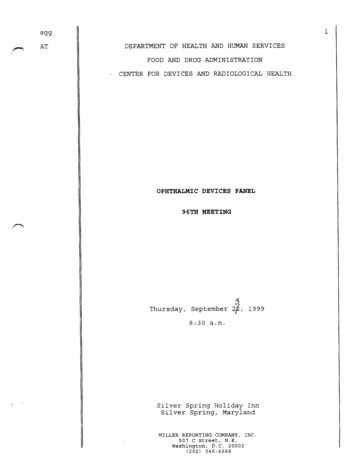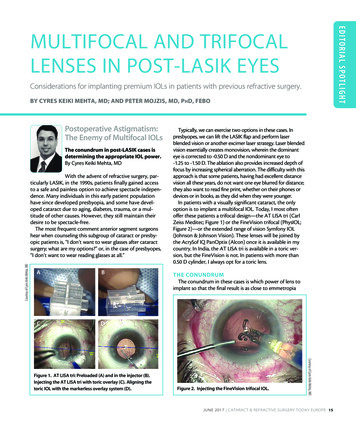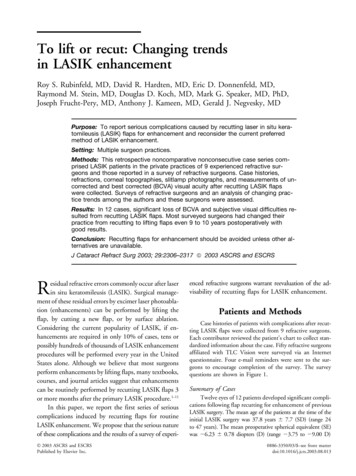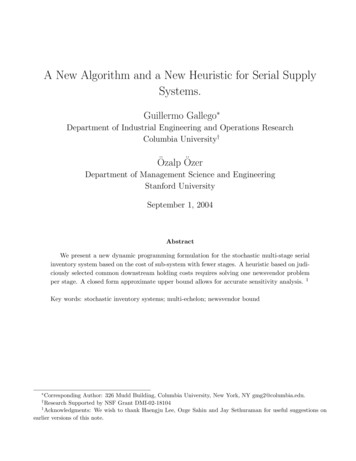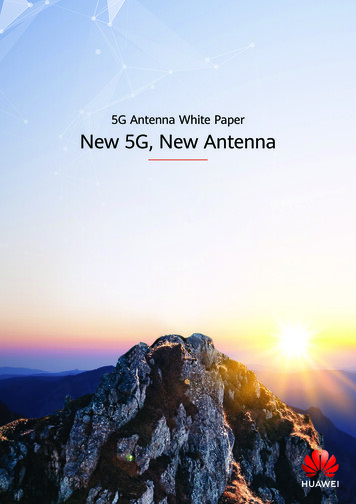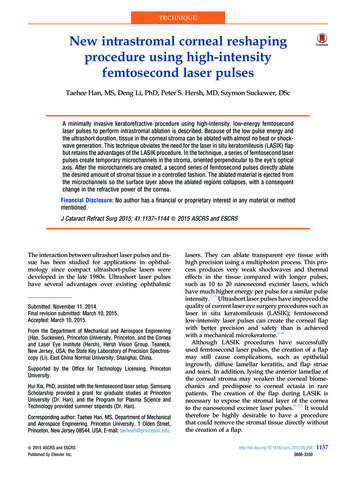
Transcription
TECHNIQUENew intrastromal corneal reshapingprocedure using high-intensityfemtosecond laser pulsesTaehee Han, MS, Deng Li, PhD, Peter S. Hersh, MD, Szymon Suckewer, DScA minimally invasive keratorefractive procedure using high-intensity, low-energy femtosecondlaser pulses to perform intrastromal ablation is described. Because of the low pulse energy andthe ultrashort duration, tissue in the corneal stroma can be ablated with almost no heat or shockwave generation. This technique obviates the need for the laser in situ keratomileusis (LASIK) flapbut retains the advantages of the LASIK procedure. In the technique, a series of femtosecond laserpulses create temporary microchannels in the stroma, oriented perpendicular to the eye’s opticalaxis. After the microchannels are created, a second series of femtosecond pulses directly ablatethe desired amount of stromal tissue in a controlled fashion. The ablated material is ejected fromthe microchannels so the surface layer above the ablated regions collapses, with a consequentchange in the refractive power of the cornea.Financial Disclosure: No author has a financial or proprietary interest in any material or methodmentioned.J Cataract Refract Surg 2015; 41:1137–1144 Q 2015 ASCRS and ESCRSThe interaction between ultrashort laser pulses and tissue has been studied for applications in ophthalmology since compact ultrashort-pulse lasers weredeveloped in the late 1980s. Ultrashort laser pulseshave several advantages over existing ophthalmicSubmitted: November 11, 2014.Final revision submitted: March 10, 2015.Accepted: March 10, 2015.From the Department of Mechanical and Aerospace Engineering(Han, Suckewer), Princeton University, Princeton, and the Corneaand Laser Eye Institute (Hersh), Hersh Vision Group, Teaneck,New Jersey, USA; the State Key Laboratory of Precision Spectroscopy (Li), East China Normal University, Shanghai, China.Supported by the Office for Technology Licensing, PrincetonUniversity.Hui Xia, PhD, assisted with the femtosecond laser setup. SamsungScholarship provided a grant for graduate studies at PrincetonUniversity (Dr. Han), and the Program for Plasma Science andTechnology provided summer stipends (Dr. Han).Corresponding author: Taehee Han, MS, Department of Mechanicaland Aerospace Engineering, Princeton University, 1 Olden Street,Princeton, New Jersey 08544, USA. E-mail: taeheeh@princeton.edu.Q 2015 ASCRS and ESCRSPublished by Elsevier Inc.lasers. They can ablate transparent eye tissue withhigh precision using a multiphoton process. This process produces very weak shockwaves and thermaleffects in the tissue compared with longer pulses,such as 10 to 20 nanosecond excimer lasers, whichhave much higher energy per pulse for a similar pulseintensity.1–5 Ultrashort laser pulses have improved thequality of current laser eye surgery procedures such aslaser in situ keratomileusis (LASIK); femtosecondlow-intensity laser pulses can create the corneal flapwith better precision and safety than is achievedwith a mechanical microkeratome.6–8Although LASIK procedures have successfullyused femtosecond laser pulses, the creation of a flapmay still cause complications, such as epithelialingrowth, diffuse lamellar keratitis, and flap striaeand tears. In addition, lysing the anterior lamellae ofthe corneal stroma may weaken the corneal biomechanics and predispose to corneal ectasia in rarepatients. The creation of the flap during LASIK isnecessary to expose the stromal layer of the corneato the nanosecond excimer laser pulses.9–13 It wouldtherefore be highly desirable to have a procedurethat could remove the stromal tissue directly withoutthe creation of a 886-33501137
1138TECHNIQUE: CORNEAL RESHAPING USING HIGH-INTENSITY FEMTOSECOND LASERRecently, the small-incision lenticule extraction procedure was developed to remove a stromal lenticulewithout creating a flap. In this procedure, a smalllenticule is prepared in the corneal stroma using atechnique similar to LASIK flap creation. As in femtosecond flap creation, the femtosecond laser pulseenergy is very low (in the nanojoule range) with lowintensity to avoid corneal tissue ablation. The lenticuleis removed using a forceps through a small accesspoint.14PRINCIPLE OF A METHOD FOR FLAPLESS CORNEALRESHAPINGWe describe a new method of flapless intrastromal keratomileusis for the correction of vision errors includingmyopia, hyperopia, and astigmatism. In this method,very-high-intensity femtosecond laser pulses changethe corneal curvature by removing stromal tissuedirectly, avoiding the flap-creation process. A schematic of the method, described in detail in the patentby Suckewer et al.,15 is shown in Figure 1. Highintensity femtosecond pulses (w1013 W/cm2) in thenear infrared wavelength range (l w 790 nm) areused to create a temporary microchannel, which is oriented perpendicular to the optical axis of the cornea.A microchannel is “drilled” approximately 150 mmbeneath the anterior surface of the cornea. When thechannel reaches the desired length, a second seriesof femtosecond pulses of higher intensity are delivered a few nanoseconds after the first series of pulsesto the endpoint of the microchannel, passing throughthe temporarily open microchannel. At this point, thefemtosecond laser pulses provide multiphoton ablation of the stromal tissue. The total amount of ablatedmaterial depends on the pulse energy and the number of pulses delivered to the endpoint. However,the rate of ablation is mainly a function of intensity,not energy, so the ultrashort pulses can produce acontrolled ablation while significantly reducing undesirable side effects. The ablated tissue material isejected from the eye through the channel used todeliver the ultrashort pulses due to the transientrecoil pressure. Even though the pressure level is sufficient to expel the ablated debris during the procedure, it does not cause significant local damageowing to the very low energy of single pulses (below100 mJ).Recently, femtosecond laser pulses have beenrecognized as a very useful tool for cutting a preciseLASIK flap.16–18 In this application, the intensity offemtosecond pulses is typically less than 108 to109 W/cm2, which is several orders of magnitudelower in intensity than that used in the multiphotonprocess described here.The multiphoton process occurs through thenearly instantaneous absorption of the energy froma significant number of photons by a single molecule, atom, or ion in the targeted material. This process produces almost no heating of the material,which is fundamentally different from the absorption of many single photons in current proceduresthat use relatively long nanosecond pulses. Innanosecond-type lasers (eg, current excimer lasers),due to relatively long laser pulses, the energy fromeach single photon is absorbed and distributedamong a large number of molecules, atoms, or ionsin the material before the next photon in the beamarrives.The multiphoton process occurs at very high intensities, whereas the single-photon process requires intensities several orders of magnitude lower but ofrelatively long duration and high energy. The latteris typical of nanosecond-type lasers applied to tissueablation and also of femtosecond lasers using lowintensities. The multiphoton process of photon–particle interaction results from absorption of a very rapidsequence of single photons in a much shorter time thanthe relaxation time of photon–particle interaction;hence, it requires a very high laser beam intensity.This should be distinguished from the fundamentallydifferent process of creating a sequence of severalphotons from single photons due to nonlinear processes in crystals (or gases). For example, for nonlinearprocesses in crystal (solids), the beam intensity cannotexceed about 1010 to 1011 W/cm2, whereas for laser–tissue interaction via multiphoton processes, thebeam intensity is on the order of 1013 to 1015 W/cm2and even higher.By creating microchannels and supplying theappropriate number of ultrashort, very highintensity pulses through such channels, the requiredfraction of the corneal tissue can be removed in acontrolled fashion. The surface layer above theremoved region then collapses, changing the curvature of the cornea. Thus, the cornea can be reshapedFigure 1. Method for flapless intrastromal keratomileusis. An ultrashort laser beam is focused by a focusing mirror at a point on thecorneal surface. A convex lens was used in the experiment (Fs Zfemtosecond).J CATARACT REFRACT SURG - VOL 41, JUNE 2015
TECHNIQUE: CORNEAL RESHAPING USING HIGH-INTENSITY FEMTOSECOND LASERin a predetermined manner keeping the surfacelayer intact. It is crucial to minimize damage to thesurface layer during this procedure. The microchannels are currently measured to be smaller than100 mm in diameter, but further work is in progressto decrease the diameters of the entrance holes toless than 50 mm.We describe a series of laboratory tests and proof-ofprinciple results of the corneal reshaping method.PROOF-OF-PRINCIPLE RESULTSThe crucial element in the corneal-reshapingmethod is the ultrashort pulses of low energy butvery high intensity at high repetition rates. Thesepulses of a single laser beam play a double role.First, they are used (at slightly lower intensity) tocreate a temporary microchannel extending fromthe surface of the cornea to a microchannel endpointlocated in the cornea. Second, higher intensitypulses (typically above 1014 W/cm2) are deliveredthrough the microchannel to an area in the corneato be ablated.Creation of Microchannels in the StromaSmall-diameter (!100 mm) and sufficiently long(R3.0 mm) channels are created in the cornea usingnonlinear laser–matter interactions in the cornealtissue by high-intensity femtosecond laser pulses.These provide an entry conduit for subsequent highintensity femtosecond laser pulses toward the tissueto be ablated by the multiphoton process.For corneal tissue, the intensity of the multiphotonprocess should be higher than 1013 W/cm2, typicallyin the range of 1013 to 1015 W/cm2. Hence, this processoccurs near the peak of pulse intensities, allowing thelaser–tissue interaction to be confined within a verysmall volume.Deep ultraviolet (UV), 10 to 20 nanosecond, excimerlasers are still used in current LASIK and photorefractive keratectomy procedures to ablate corneal tissueby the absorption of many single photons. Suchdeep UV laser pulses cannot be applied to internalcorneal tissue because they are too low in intensity(107 w 109 W/cm2) and have a highthreshold energyfluence (pulse energy per unit area), about 100 timeshigher than the threshold energy fluence of a femtosecond laser pulse for ablation of corneal tissue(w1 J/cm2). This high-threshold energy fluence ofnanosecond-type lasers19,20 leads to a large interactionarea. It also implies that there is more energy conversion to harmful mechanical effects on tissue thanwith femtosecond pulses. Moreover, only such ultrashort laser pulses can create sufficiently narrow microchannels in the cornea to mediate intrastromal1139ablation. In the method we describe, the laser beam,usually oriented perpendicular to the optical axis,should be able to penetrate the corneal tissue withoutabsorption until it is focused on the target point deepin the stroma with an intensity sufficient to cause themultiphoton process. Thus, the wavelength of the laserbeam should be in a range that corneal tissue cannotabsorb when the intensity is in the linear region.Microchannels of very small diameter and sufficientlength are mutually incompatible conditions in diffraction optics. A lens of short focal length is needed for asmall channel diameter in relation to the small focaldiameter. A lens with a much longer focal length hasto be used for an elongated channel, in relation to thelonger Rayleigh length. Fortunately, a short focallength, high-intensity femtosecond laser pulse maycontribute to the elongation of the microchannels dueto self-focusing of the laser pulse and the filamentationphenomenon in a transparent or partially transparentmedia.Double-Pulse Scheme for Reshaping Corneal TissueIn the single-pulse scheme, a microchannel iscreated and elongated by an accumulation of manyhigh-intensity femtosecond pulses. A repetitionrate of 1 kHz and higher is required to keep the microchannel open during the process of stromal tissueremoval because the channel can collapse within afew milliseconds. High-intensity pulses propagatinginside the temporary channel may interact with thetissue debris ablated by the preceding pulse andwith partially collapsing tissue walls. Furthermore,bubbles generated by cavitation and trapping ofthe gaseous ablation debris around previouslycreated channels scatter the pulses and disturb creation of a new neighboring channel. This may lead toconsiderable energy loss toward the end of the channel near the cornea-reshaping area and may causedifficulties in delivering pulse energy with high efficiency to the targeted area of tissue removal. Therefore, significantly higher pulse energy than thethreshold value is needed to create a sufficientlylong microchannel (w3.0 mm). The high-intensitypulses affect not only the intended tissue, but alsothe whole channel through which the pulses shouldpass with only minimum interaction. Consequently,the interaction between the high-intensity pulsesand the whole channel results in excessive removalthroughout the whole channel, including theentrance area.Given these drawbacks of a single-pulse method, adouble-pulse scheme was developed to enhance energy efficiency and control tissue ablation better.Ablation in the channel entrance must be at theJ CATARACT REFRACT SURG - VOL 41, JUNE 2015
1140TECHNIQUE: CORNEAL RESHAPING USING HIGH-INTENSITY FEMTOSECOND LASERFigure 2. Images of corneal ablationby (A) the femtosecond laser beamof single pulses and (B) the femtosecond laser beam of double pulseswith delay between split pulses of0.5 nanoseconds. The entranceholes of the microchannels are onthe upper right side of each picture.A much brighter and well-confinedablation spark is observed at theend of the microchannel (B). Cavitation bubbles are also seen aroundthe microchannels.minimum level because it has to act only as a passagefor femtosecond pulses to the desired tissue removalarea. In the double-pulse scheme, each shot has a pairof pulses with a delay between them on the order ofnanoseconds and the overall repetition rate remains1 kHz (1 millisecond between 2 consecutive shots).Plasma created by the initial pulse21,22 during channel drilling (pre-generated plasma) can evolvefavorably to guide the subsequent main femtosecondpulse. This main pulse is focused on the pregenerated plasma and delivered deep into the stromawith some elongation of its focal depth.23,24 Hence,effective and highly localized multiphoton ablationof tissue at the endpoints of the microchannels isachieved. The main pulses also contribute to elongation of the microchannels during the propagation. Acomparison of the visual effect of the single-pulseand the double-pulse (delay of about 0.5 nanosecondsand longer between 2 sequential pulses) schemes isgiven in Figure 2. It shows that with the same initialexperimental conditions in both schemes, a muchbrighter and well-confined ablation spark occurs atthe end of the microchannel in the double-pulsescheme.Corneal-Reshaping Experiments Using Double-PulseLaser BeamsIn this paper, 2 procedures for reshaping stroma arepresented. For myopia correction, the focus ofincoming light has to be shifted downward to theretina by flattening the corneal curvature; thus, thelaser pulses should ablate the stromal tissue in a spherical or toric area below the surface layer (Figure 3, A),resulting in a decrease in the total refractive powerof the eye. Typically, an ablation depth of less than150 mm is required at the center of the stroma. Forhyperopia correction, a toroidal area in the stromashould be removed (Figure 3, B) to increase the curvature of the cornea, resulting in an increase in the totalrefractive power of the eye.25 In both cases, the microchannels in the stroma are made by rotating the beamdirection around the channel entrances to cover thewhole removal area with a few holes, as illustratedin Figure 3. After the procedure, the surface layerabove the removed area starts to collapse, correctingthe curvature of the eye.The amount of tissue removed can be preciselycontrolled by adjusting the pulse energy and the exposure time to the main beam. Therefore, different pulseFigure 3. Top view for illustratingthe method of reshaping corneasfor correction of (A) myopia and(B) hyperopia. Removal of stromaareas of circle and torus are proceeding by rotating the directionof the laser beams around the entrances of the channels.J CATARACT REFRACT SURG - VOL 41, JUNE 2015
TECHNIQUE: CORNEAL RESHAPING USING HIGH-INTENSITY FEMTOSECOND LASER1141Figure 4. Schematic of the experimental setup for the flapless cornealreshaping.energies and exposure times of pulses can be appliedin different locations according to the amount of tissueto be removed. For example, an ablation shape formyopia correction should resemble a convex lens.Higher intensity and an increased number of pulseshave to be delivered to the deeper region until themicrochannel reaches the center of the stroma. Incontrast, a constant amount of ablation along thewhole microchannel is required for hyperopiacorrection.To test the procedure, fresh porcine eyes were usedin the experiments, the setup of which is depicted inFigure 4. A mode-locked seed pulse from a Ti:Sapphirelaser oscillator (l Z 790 nm, t z 100 femtoseconds)was amplified by combining pulse stretchingfollowing its amplification in regenerative amplifierand recompression to t z 100 femtoseconds (chirpedpulse amplification technique) at the 1 kHz repetitionrate. In this way, very high output beam intensitiescan be obtained after focusing. The first splitter locatedon the beam path divides each pulse into the pre-pulseand main pulse, with a delay of approximately 0.5nanosecond. The second splitter merged the pulsesto have the same focal points, although with delay.Both pulses were focused by the same convex lens(f Z 215 mm) onto a porcine cornea located on a rotational stage. The porcine corneas were obtained from alocal abattoir and kept in wet ice until they were testedwithin a day.In the tests for myopia correction, flattening the curvature of the cornea, initially only the pre-pulses(pulse energy w45 to 55 mJ) were turned on to createa microchannel in the cornea. As the microchannelreached the area to be removed, the main pulseswith approximately the same or somewhat higherenergy were initiated. However, for hyperopiaFigure 5. A contact glass is placedon the eye for uniform ablation bycreating a straight microchanneland to minimize the channelentrance hole diameter.J CATARACT REFRACT SURG - VOL 41, JUNE 2015
1142TECHNIQUE: CORNEAL RESHAPING USING HIGH-INTENSITY FEMTOSECOND LASERFigure 6. Images of the tested corneas after each test. Left imagesshow the eye reshaped in a circleimmediately after the test (A) anda day after (B). Right images showthe eye reshaped in a torus immediately after the test (C) and a dayafter (D). A grid in the ruler indicates 0.5 mm.correction (reshaping in a toroidal form), a singlepulse scheme was successfully applied since it wasnot necessary to create a long channel to reshape thecornea in a toroidal shape. As illustrated in Figure 3,the shape of removed tissue can be obtained withseveral relatively short microchannels. Microchannelswith many smaller entrance holes allow the use of asingle-pulse scheme and relatively low energy levelsfor hyperopia correction, minimizing trauma to thecorneal surface.It is important to ablate tissue at a constantdistance from the corneal surface. As shown inFigure 5, a contact glass was placed on the eye asan applanator. T
LASIK flap.16–18 In this application, the intensity of femtosecond pulses is typically less than 108 to 109 W/cm2, which is several orders of magnitude lower in intensity than that used in the multiphoton process described here. The multiphoton process occurs through the nearly instantaneous absorption of
